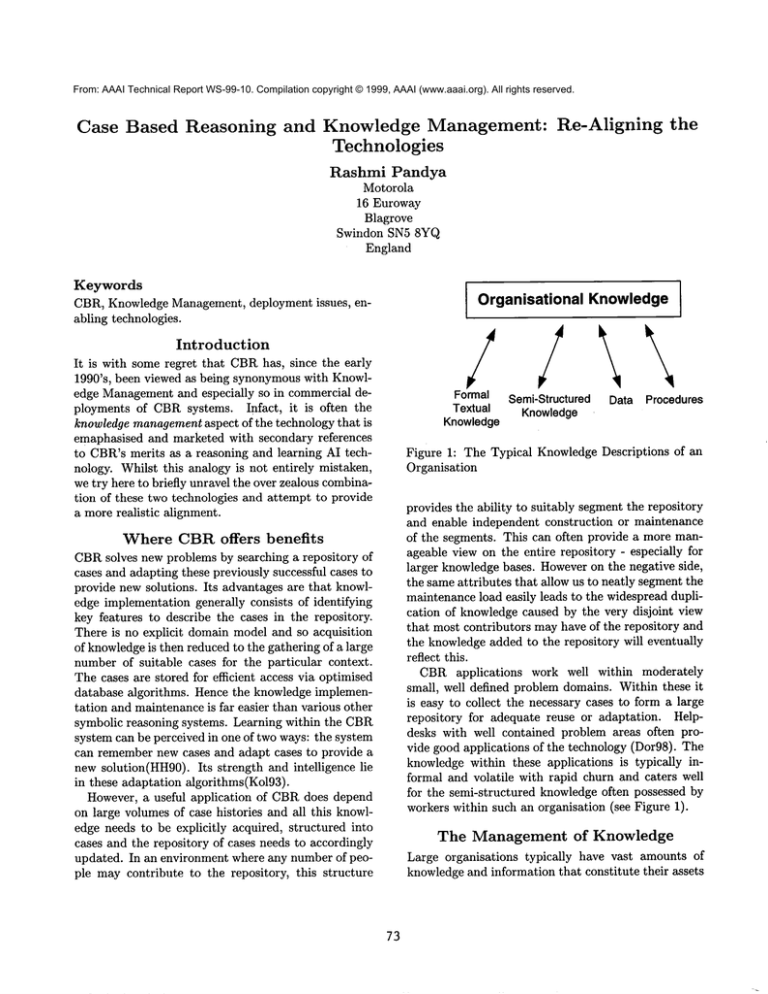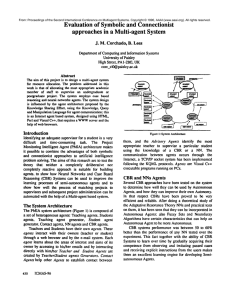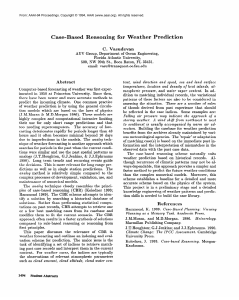
From: AAAI Technical Report WS-99-10. Compilation copyright © 1999, AAAI (www.aaai.org). All rights reserved.
Case Based Reasoning
and Knowledge Management:
Technologies
Re-Aligning
the
Rashmi
Pandya
Motorola
16 Euroway
Blagrove
Swindon SN5 8YQ
England
Keywords
CBR, Knowledge Management, deployment issues,
abling technologies.
OrganisationalKnowledge
en-
Introduction
It is with some regret that CBRhas, since the early
1990’s, been viewed as being synonymous with Knowledge Managementand especially so in commercial deployments of CBRsystems. Infact, it is often the
knowledge managementaspect of the technology that is
emaphasised and marketed with secondary references
to CBR’smerits as a reasoning and learning AI technology. Whilst this analogy is not entirely mistaken,
we try here to briefly unravel the over zealous combination of these two technologies and attempt to provide
a more realistic alignment.
/ /
Formal Semi-Structured Data Procedures
Textual
Knowledge
Knowledge
Figure 1: The Typical Knowledge Descriptions
Organisation
of an
provides the ability to suitably segment the repository
and enable independent construction or maintenance
of the segments. This can often provide a more manageable view on the entire repository - especially for
larger knowledge bases. Howeveron the negative side,
the same attributes that allow us to neatly segment the
maintenance load easily leads to the widespread duplication of knowledge caused by the very disjoint view
that most contributors may have of the repository and
the knowledge added to the repository will eventually
reflect this.
CBRapplications
work well within moderately
small, well defined problem domains. Within these it
is easy to collect the necessary cases to form a large
repository for adequate reuse or adaptation. Helpdesks with well contained problem areas often provide good applications of the technology (Dor98). The
knowledge within these applications is typically informal and volatile with rapid churn and caters well
for the semi-structured knowledge often possessed by
workers within such an organisation (see Figure 1).
Where CBR offers
benefits
CBRsolves new problems by searching a repository of
cases and adapting these previously successful cases to
provide new solutions. Its advantages are that knowledge implementation generally consists of identifying
key features to describe the cases in the repository.
There is no explicit domain model and so acquisition
of knowledgeis then reduced to the gathering of a large
number of suitable cases for the particular context.
The cases are stored for efficient access via optimised
database algorithms. Hence the knowledge implementation and maintenance is far easier than various other
symbolic reasoning systems. Learning within the CBR
system can be perceived in one of two ways: the system
can remember new cases and adapt cases to provide a
new solution(HH90). Its strength and intelligence lie
in these adaptation algorithms(Ko193).
However, a useful application of CBRdoes depend
on large volumes of case histories and all this knowledge needs to be explicitly acquired, structured into
cases and the repository of cases needs to accordingly
updated. In an environment where any number of people may contribute to the repository, this structure
The Managementof Knowledge
Large organisations typically have vast amounts of
knowledgeand information that constitute their assets
73
(Figure 1) and the application of knowledge management is usually from a desire to exploit and share this
knowledgefor the benefit of the organisation’s services.
Knowledge management strives to attach a form and
structure to what may be large shift in workflow and
attitude.
We focus here on Knowledge Management as the
science of managing knowledge and not the peoplecentric social aspects of this vast field such as that
described in (Sve97).
Knowledge Management aims to provide the structures and strategies necessary for efficient and productive knowledge construction and exploitation. To this
end, there are various process oriented strategies such
as those described in (Sky98) and the Balance Scorecard (an interesting application of this is described in
(Mot98)). In its most generic form a knowledge management lifecycle spans through the acquisition or creation of knowledge, the development of this knowledge
in order to mould it for suitable exploitation (knowledge engineering in AI) and the correct storing of this
knowledge to make it conducive to sharing.
However, Knowledge Management also provides a
holistic view to dealing with knowledge- dealing with
all the forms of knowledge that commonly exist in
the organisation’s
memory. The knowledge and expertise about a particular subject is rarely completely
attributable to just one of these types of knowledge
shown in Figure 1 especially when dealing with complex technical environments. More realistically
this
knowledge consists of
¯ semi-structured
knowledge held by experts
¯ formal rules and procedures for various situations
¯ historical
data - numerical or otherwise
¯ internal (formal or informal) and reference documents in textual format.
A sound and thorough Knowledge Management initiative must deal with all these instances.
Another dimension that is often forgotten in KM
applications is the ability to manageand share various
levels of knowledge:
¯ concrete knowledge that addresses specific applications
¯ abstract knowledge that addresses more general issues.
The ability for all users to traverse these levels of
knowledge and the awareness that one piece of knowledge can be both concrete and abstract in different
contexts is not just a usability issue but a fundamental part of KMand correct knowledge representation.
The reusability of concrete and abstract knowledgeassets is thoroughly considered in (Boi98).
Finally, we must consider the desired effect of good
knowledge managementand sharing initiatives
- creating new knowledge and innovative solutions. The
intention is that in sharing organised information we
may then extrapolate and form new semantic connections to form new or previously unknown knowledge
(as we do in many data mining techniques). KMsystems must provide an arena conducive to such learning.
This may include an area to share knowledgeoutside of
a formal system and also various views on the knowledge within the system.
Deploying
CBR Systems
Successful large scale CBRdeployment relies on the application of KMfrom the very beginning in the form
of a strategy (Jon97). This strategy must address the
purpose of the system and circumvent the problem
area. It must also deal with the lifecycle aspects of
the knowledge and the personnel attached to this cycle. This is imperative for an up-to-date and consistent knowledgebase, especially when there are several
or more authors.
As we noted above, the knowledge applied in a CBR
system is primarily semi-structured; textual or procedural knowledge and data are not handled well in
CBRapplications,
although there are notable document retrieval
CBRsystems (WW97)and efforts
combine CBRwith systems that reason with formal
rules(LK98). So from Figure 1 we note that a large
portion of organisational knowledge is not dealt with
solely by CBR.
CBRsystems are traditionally queried by textual or
numerical strings that a user types in. The system returns with possible solutions, or if it is a dialogue CBR
system, with a series of questions to further streamline
the search. There is rarely an opportunity for more
than one view to the knowledge contained in the case
base. The knowledge is stored and returned as cases.
This provides only one view for the user.
CBRsystems provide little in the way of support
for nurturing innovative ideas since solutions are entirely based on things that have worked and succeeded
before.
CBR C KM Enabling
Technologies
In the previous section we commented on how large
scale CBRprojects need supporting Knowledge Management strategies, but it is also appropriate to consider what CBRoffers towards the management of
CBR
Assessing
14
KM
Acquire
____J
-~ Retrieving
......
Management.It is perhaps more precise to classify it
as one of a set of enabling technologies for Knowledge
Management.
References
~ Adapting
~[ Applying
Develop
Max H. Boisot. Knowledge Assets: Securing Competitive Advantage in the In/ormation Economy. Oxford
University Press, 1998.
Share
Peter Dorfman. Towards a Knowledge-Based Customer Support Program. Knowledge Management Review, 1:4:24-33, 1998.
Retain
D. Hinkle and D. Hennessy. Clavier: A Case-Based
Autoclave Loading Advisor. In Proceedings: Fabricating Composites 90, Society of Manufacturing Engineers, 1990.
.~ Evaluating
I
~[ Storing
Andy Jones. Applying CBRat BT. In Proceedings:
CBRand Data Mining: Putting the technology to use,
pages 39-63, Unicom Seminars, UK, 1997.
Figure 2: KMand CBRworking alongside eachother.
Janet Kolodner. Case-Based Reasoning. Morgan
Kaufmann, San Mateo, CA, 1993.
¯ David B. Leake and Andrew Kinley. Combining reasoning modes, levels and styles through internal cbr.
In Proceedings: Multimodal Reasoning, pages 141146, AAAISpring Symposium, Technical Report SS98-04, 1998.
knowledge.
Figure 2 shows how the generic process of knowledge
¯ management may be supported by CBR. We can see
that the KMprocesses of acquiring knowledge, developing, sharing and retrieving knowledgeare all catered
for at varying degrees by a CBRsystem. We acquire
knowledge when we assess new knowledge to be added
to the system or in retrieving knowledge from the CBR
system. Developing the knowledge can involve adaptation in a CBRapplication or knowledge engineering
in a CBRapplication without explicit case adaptation.
The very process of evaluating the knowledgefor suitability is an instance of sharing the knowledgein the
system. So although we have stated that the application of KMprocesses are imperative to the success
of CBRprograms it is also true to note that some of
these processes are intrinsic to the way CBRsystems
survive.
Muchof these KMactivities lie outside the system
itself, for example, acquiring and developing knowledge is invariably done by knowledge authors. CBR
excels at the retrieving of semi-structured knowledge
and provides an environment for sharing knowledge.
Knowledge Management requires crossing borders
with other disciplines and AI being one of the founding
motivations behind KMneeds to be adequately represented - not just by CBRbut the many other technologies and algorithms that deal with all the other types
of knowledge that we have referred to in this paper.
Weconclude here that although CBRprovides a selfcontained, easily accessible method of maintaining a
subset of organisational knowledge, it is misleading to
view it as an all encompassing solution to Knowledge
Virginia Morrow. Case Study: Two Developments of
the Balanced Scorecard. In Virginia Morrow, editor,
Knowledge Management Magazine. Learned Information, Oxford, UK, 1998.
David J. Skyrme. Developing a Knowledge Strategy.
In Strategy. Strategic Planning Society, 1998.
Karl E. Sveiby. The Invisible
Balance Sheet. 1997.
Ian Watson and Heather Watson. CAIRN: A CaseBased Document Retrieval System. In Proceedings:
3rd United Kingdom Case-Based Reasoning Workshop, University of Manchester, 1997.
75





